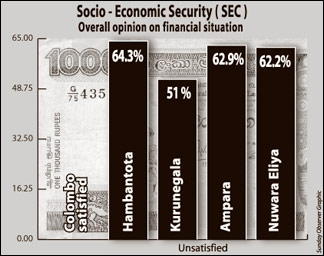Are we all suffering from poverty?
Two surveys reveal...:
by Indeewara Thilakarathne
 Poverty is relative. Compared to ten per cent of the super rich, the
ordinary members of the society are poor. However, the benchmark or the
poverty line in Sri Lanka is around a monthly income of Rs.1000. If a
person earns a monthly income of Rs.1000 or less than the sum, he or she
is considered as poor. Poverty is relative. Compared to ten per cent of the super rich, the
ordinary members of the society are poor. However, the benchmark or the
poverty line in Sri Lanka is around a monthly income of Rs.1000. If a
person earns a monthly income of Rs.1000 or less than the sum, he or she
is considered as poor.
Although most of the employed persons who belong either to the lower
middle class or upper middle class earn a monthly income of Rs.
5000-Rs.10, 000, it is a home truth that more than 50% of their income
is spent on basic needs and on transport.
In the light of the Social Policy Analysis and Research Centre (SPARC)
/ ILO Socio-Economic Security Survey (SES), the majority of the
respondents admitted that their income was inadequate to meet their food
expenditure, Education and Health Care, although health care is by and
large provided free by the Government.
 SES has, among other things, found out the existence of significant
regional variations with regard to the degree of poverty at different
levels; in urban sector only 5% earns below national poverty line
compared to rural and plantation sectors 11% and 15 % respondents are
below poverty line. Lack of opportunities in remote locations (highest
poverty incidence in Uva province), Tsunami disaster and conflict
related poverty (Batticaloa) have been cited as reasons for the
existence of higher level of poverty in diverse sectors. SES has, among other things, found out the existence of significant
regional variations with regard to the degree of poverty at different
levels; in urban sector only 5% earns below national poverty line
compared to rural and plantation sectors 11% and 15 % respondents are
below poverty line. Lack of opportunities in remote locations (highest
poverty incidence in Uva province), Tsunami disaster and conflict
related poverty (Batticaloa) have been cited as reasons for the
existence of higher level of poverty in diverse sectors.
One of the significant findings of the survey is that the majority of
the respondents have very low expectation about their income security in
their old age.
This has wider social implications given significant changes in the
age-pyramid towards ageing population. On the other hand, the findings
also indicate the total or partial failure of social security schemes
such as pension, EPF and ETF against rising inflation, resulting in the
higher cost of living.
The respondents have also expressed concern about the rising cost of
health care which has been cited as a major financial burden, clearly
sending warning signals to health policy makers that there might be
marked discrepancies in the free health care facilities offered by the
Government sector , though it has substantially contributed to increase
the life expectancy in Sri Lanka.
Among the significant findings of the SLFS are that salaried workers
are very low among industrial workers and the wage differentials are
high between small, medium and large firms.
 With regard to the availability of training opportunities, it has
been found out that very little training opportunities are available for
workers in all categories and that training is more or less confined to
'on the job training'. With regard to the availability of training opportunities, it has
been found out that very little training opportunities are available for
workers in all categories and that training is more or less confined to
'on the job training'.
According to researcher Mahinda Pushpakumara, highest labour turnover
(mean moving of workers from one establishment to another either on
voluntary or in-voluntary basis in a given period) has been observed
among small scale establishments.
One of the indirect results of the higher labour turnover is that
pruning of training opportunities, especially, in small business
establishments and agency-hired workers who have been deployed in lower
categories of employment.
SLFS also found out that although majority of business establishments
provides non-wage benefits such as medical benefits in case of
accidents, sick leave and paid leave, very few firms provide most
sustaining benefits such as pension and retrenchment benefits.
The surveys should be a must read for policy makers in order to come
to terms with some of the grim realities and discrepancies in the
existing policies, especially in health and social welfare sectors.
****
Socio-Economic Security (SES) Survey and Enterprises Labour
Flexibility and Security (ELFS) Survey were conducted by the Social
Policy Analysis and Research Centre (SPARC) at the University of
Colombo.
The Surveys were conducted as a part of an International Study
coordinated and financed by the ILO under its Socio-Economic Security
Programme. SES was conducted in five districts; Colombo, Hambantota,
Kurunegala, Ampara and Nuwara Eliya.
Findings of the SES
1. Majority of respondents are wage earners (57.2); own account
workers (41.0) also constitute a large portion of the sample.
2. Most of wage earners are in private sector, formal and informal
(70%).
3. Self-employed persons are mostly concentrated in the agriculture
(40.5) and service (37.6) sector. Only 7% of the self-employed are in
manufacturing.
4. Nearly 50% of households in Colombo belong to the higher income
group (more than Rs.10, 000 per month). Low-income category (below
Rs.5000) predominates in more disadvantaged districts, i.e. Hambantota
(47%) and Nuwara Eliya (48%).
5. In all districts a large majority of households report that their
income is inadequate to meet their food expenditure (61%), Education
(69.3) and Health Care (67.2%).
6. Majority in disadvantaged districts like Hambantota (52.3%) and
Ampara (59.6%) report worsening of their financial situation over the
last few years. A large population of households in Colombo (33.8%) and
Kurunegala (27.4%) report an improvement of their financial situation.
7. A large majority of households in all districts except in Colombo
are not satisfied with their financial situation, Kurunegala 51%,
Hambantota 64.3%, Ampara 62.9 % and Nuwara Eliya 62.2%.
8. As for expectations regarding future financial prospects, there
are significant regional variations. Nearly a third of the households
(31.3%) feel that the situation will get worse. Households in Colombo
(22.6%) and Nuwara Eliya (23.8%) have a more positive out look.
9. The large portion of the respondents (39.5%) expect income support
from children and relatives in old age. Nearly 20% of respondents intend
to continue working in order to support themselves.
10. Over 50% of the respondents are not hopeful about income security
in their old age. A significant portion (18%) has no idea regarding
future income security.
11. Health related costs are the most widely mentioned as affecting
the financial situation of households (29%). Debt burden comes next
(20.4%).
12. Unemployment rate among male is 11% whereas female unemployment
rate is 20%.
****
Findings of ELFS
The survey was conducted in Colombo, Gampaha and Kalutara districts
in the Western province and Kurunegala district in Wayamba province and
Ratnapura district in Sabaragamuwa province.
1. Out of the workforce, nearly 5% of them are unpaid family workers
and 68% of them are regular workers, 27% are non-regular workers
(contract, casual & part-time). Only 0.5% workers are agency-hired.
2. High level of gender-segregation is observed in certain
occupational categories. Out of total employees covered in the survey,
52% are female. Among managerial, executive and administrative level
categories, 19% of workers are female.
However, within professional and technical categories, 88% are male.
Only 12% of professional and technical workers are female. It is further
observed that for the technical etc. category, employers prefer to hire
male workers indicating the existence of a gender bias in selections.
3. Only 27% of the establishments provide training placement for the
apprentices.
4. Since 2005 November 31st to 2006 April 30th 11,527 vacancies have
been filled by these establishments.
5. Out of total vacancies, only 8% are filled through internal
promotions. Advertisement (47%) and personal contact (42%) are main
sources of vacancy filling. In the household survey, it came out that
25% of job applicants have approached the prospective employer through
personal contacts.
6. During this period, 65% of new recruitments are on regular basis
and 31% are hired as temporary workers indicating a trend towards
flexibilisation.
7. During the six month reference period labour turn over as a
percentage of total workforce was found to be 18%. In addition, Labour
Turn over is high among the production workers.
8. Highest Labour Turnover rate was reported from small-scale
establishment (21%).
9. Work related accidents in the past 12 months reported only from
12% establishments.
10. Out of the total establishments only 3.5% , establishments have
unions.
[email protected] |
